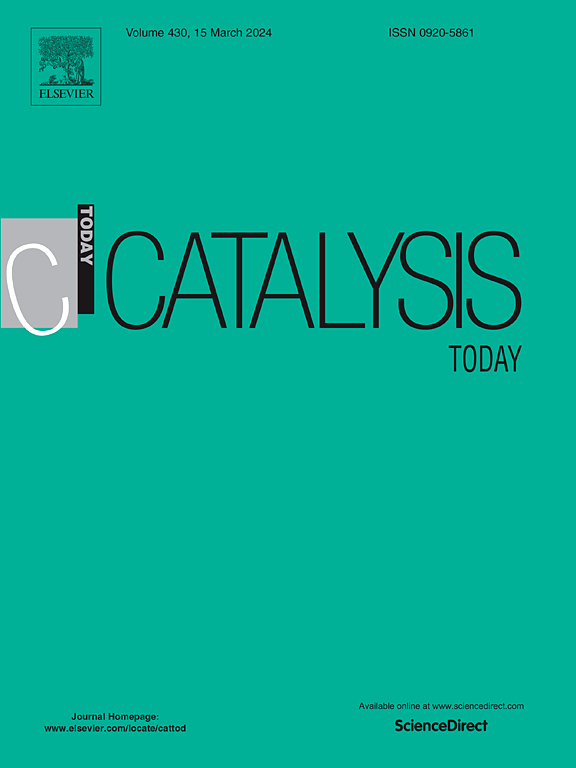还原氧化石墨烯促进电荷在二苯并噻吩- s, s -二氧化二氮基线性共轭聚合物上的转移,实现过氧化氢的高效光合作用
IF 5.3
2区 化学
Q1 CHEMISTRY, APPLIED
引用次数: 0
摘要
线性共轭聚合物作为一种多用途的可见光催化剂,由于其可调谐的光电特性而吸引了越来越多的关注。然而,它们的线性骨架往往导致电子转移不足,这一限制可以通过将它们与导电π共轭体系(如还原氧化石墨烯(rGO))耦合来缓解。在这里,我们报道了二苯并噻吩- s, s -二氧化二氮基共轭聚合物(PSOBN2)与氧化石墨烯的静电自组装,形成PSOBN2-氧化石墨烯异质结构。还原氧化石墨烯的二维共轭结构通过界面耦合促进π电子在PSOBN2上的转移,从而克服了线性共轭聚合物固有的载流子输运限制,增强了电荷分离,加速了界面电子转移。优化后的异质结构PSOBN2- rgo1在可见光照射下的H2O2产率为9972 μmol h-1 g-1,是原始PSOBN2的1.42倍。值得注意的是,在自然阳光照射下,PSOBN2-rGO1在初始1小时内产生H2O2的速率为9267 μmol h-1 g-1。机制研究证实了rgo促进的电子转移在促进H2O2光合作用的O2还原和H2O氧化双途径中的关键作用。这项工作为克服线性共轭聚合物对H2O2的有效人工光合作用的固有局限性提供了一种策略。本文章由计算机程序翻译,如有差异,请以英文原文为准。
Reduced graphene oxide facilitates charge transfer over a dibenzothiophene-S,S-dioxide-based linear conjugated polymer for efficient photosynthesis of hydrogen peroxide
Linear conjugated polymers have emerged as a versatile class of visible light photocatalysts, attracting increasing interest due to their tunable optoelectronic properties. However, their linear backbones often result in insufficient electron transfer, a limitation that can be mitigated by coupling them with a conductive π-conjugated system such as reduced graphene oxide (rGO). Here, we report the electrostatic self-assembly of a dibenzothiophene-S,S-dioxide-based conjugated polymer (PSOBN2) with rGO, forming a PSOBN2-rGO heterostructure. The two-dimensional conjugated structure of rGO facilitates π-electron transfers over PSOBN2 through interfacial coupling, thereby overcoming the inherent charge carrier transport limitation of linear conjugated polymers for enhanced charge separation and accelerated interfacial electron transfer. An optimized heterostructure, PSOBN2-rGO1, exhibits a better H2O2 production rate of 9972 μmol h–1 g–1 in an air atmosphere under visible light irradiation, which is 1.42 times that of pristine PSOBN2. Notably, under natural sunlight irradiation, PSOBN2-rGO1 demonstrates an exceptional H2O2 production rate of 9267 μmol h–1 g–1 within the initial hour. Mechanistic studies confirm the crucial role of rGO-facilitated electron transfer in promoting the reduction of O2 and oxidation of H2O dual pathways for the photosynthesis of H2O2. This work offers a strategy for overcoming the inherent limitations of linear conjugated polymers toward efficient artificial photosynthesis of H2O2.
求助全文
通过发布文献求助,成功后即可免费获取论文全文。
去求助
来源期刊

Catalysis Today
化学-工程:化工
CiteScore
11.50
自引率
3.80%
发文量
573
审稿时长
2.9 months
期刊介绍:
Catalysis Today focuses on the rapid publication of original invited papers devoted to currently important topics in catalysis and related subjects. The journal only publishes special issues (Proposing a Catalysis Today Special Issue), each of which is supervised by Guest Editors who recruit individual papers and oversee the peer review process. Catalysis Today offers researchers in the field of catalysis in-depth overviews of topical issues.
Both fundamental and applied aspects of catalysis are covered. Subjects such as catalysis of immobilized organometallic and biocatalytic systems are welcome. Subjects related to catalysis such as experimental techniques, adsorption, process technology, synthesis, in situ characterization, computational, theoretical modeling, imaging and others are included if there is a clear relationship to catalysis.
 求助内容:
求助内容: 应助结果提醒方式:
应助结果提醒方式:


